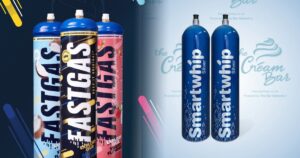Safety Tips for Using CO2 Tanks
FastGas Blog
If you are using, transporting, and storing CO2 tanks or carbon dioxide cylinders for food purposes, this guide is something for you. Today we bring you some essential facts regarding CO2 tanks’ safety. Don’t miss any!
Using CO2 Tanks Safely
Working safely with carbon dioxide means understanding this gas’s physical and chemical characteristics and taking suitable safety precautions.
Therefore, as probably the most crucial feature, you need to know that carbon dioxide is non-inflammable, chemically stable, and inert under atmospheric conditions. It won’t react (quickly) to combustion interaction. Nevertheless, it can respond to ammonia or amines.
Secondly, and worth emphasizing, CO2 is approximately 1.5 times as heavy as air at atmospheric pressure, for which the physical states of this gas deserve your attention:
- At atmospheric pressure, CO2 is gaseous.
- At temperatures between 56.6 and +31.1°C, CO2 can exist in liquid form.
- At temperatures below -56.6°C can occur in a solid state.
In what state is then the gas compressed in a CO2 tank?
Compressed gasses such as CO2, nitrous oxide, and oxygen are all gasses at room temperature. However, once these gasses cool enough, they become liquid, which is how you store them in gas containers.
Consequently, in the gas cylinder, CO2 is in a liquid state.
We recommend you use a pressure regulator to set the proper outlet pressure of less than 5.2 bar. The tension in the cylinder is approximately 57 bar at 20°C.
Health Precautions When Using CO2 Tanks
So far, you are aware that CO2 is non-inflammable. But CO2 is also colorless, odorless, and tasteless. Hence, practically impossible to detect with the human senses.
Given this disadvantage, you need to be twice more careful when exposed to higher concentrations of CO2. It can be unhealthy.
The following health precautions are advisable:
- Keep the CO2 system gas-tight. Seal any leaks immediately. Gas leaking in a confined place can cause suffocation and death.
- Keep CO2 tanks well-ventilated.
- If a sudden CO2 discharge of emission occurs, prioritize the immediate evacuation of low-lying areas.
- Keep CO2 extinguishing systems nearby in all possible sensitive rooms. The threat to humans can be severe if the carbon dioxide reaches ducts, ventilation tubs, or air conditioning systems.
Handling CO2 Tanks
If we want to enjoy all CO2 tanks’ benefits, we must know how to handle a single bottle to ensure everything goes smoothly.
Here’s how you can stay safe when handling CO2 tanks:
First and foremost, ensure you have fully read all safety guidelines before proceeding.
Second, control your CO2 cylinder’s weight. All cylinders you receive already filled must meet specific requirements so they can reliably withstand the pressure. If a CO2 cylinder weighs more than stated on the bottle, the pressure inside the cylinder can quickly increase with a slight temperature rise.
- The pressure in a CO2 cylinder depends solely on temperature. At 20°C, for example, it is 57 bar. Even an almost empty CO2 cylinder remains at 57 bar at 20°C as long as it contains the liquid phase.
Third, when ready to open the valve, position the bottle vertically with the valve pointing to the sky. Sometimes the compressed gas can come with the extra pressure that can be dangerous if in contact with your face or body.
Fourth and lastly, only connect CO2 gas cylinders to primary regulators. Upon request, our FastGas team can provide you with pressure regulators in bulk.
Transporting and Storing CO2 Tanks
The transport of CO2 tanks is not much different than transporting nitrous oxide cylinders. The previous said, when transporting by road and vehicle, secure the pallets with unique strings and foil so the shipment doesn’t displace. The car or truck should have good ventilation and enough space for a trolley. A trolley saves you logistic effort.
In parallel, regarding storing, it is vital to keep the bottles out of direct sunlight to prevent an increase in temperature, which eventually will lead to a rise in pressure. You should also keep the bottles away from corrosive atmospheres and ensure they are correctly labeled.
Where to Buy a CO2 Cylinder?
Are you wondering where to purchase a high-quality CO2 cylinder? Look no more and click here to shop our FastGas CO2 cylinder. Available in 600 grams, perfect for domestic use.
Contact us for further information regarding the functionalities of this new product.





